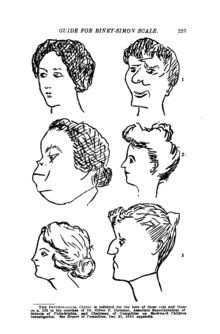Alfred Binet
Binet was born as Alfredo Binetti in Nice, which was then part of the Kingdom of Sardinia until its annexation by the Second French Empire in 1860, and the ensuing policy of Francization.
Binet aggressively supported Charcot's position which included the belief that people with weakened, unstable nervous systems were susceptible to hypnosis.
Unfortunately, the conclusions of Charcot, Binet and Féré did not stand up to the professional scrutiny of Joseph Delboeuf, who concluded that the findings were due to the fact that the patients knew what was expected, what should happen, and they just agreed.
Binet called Alice a subjectivist and Marguerite an objectivist, and developing the concepts of introspection and externospection in an anticipation of Carl Jung's psychological types.
[7]: 702–3 In the 21-year period following his shift in career interests, Binet "published more than 200 books, articles, and reviews in what now would be called experimental, developmental, educational, social, and differential psychology.
[9] Because Binet did not have any formalized graduate study in psychology, he did not hold a professorship with a prestigious institution where students and funds would be sure to perpetuate his work.
French education changed greatly at the end of the nineteenth century, because of a law that passed which made it mandatory for children ages six to thirteen to attend school.
In this endeavor, Binet was helped greatly by Théodore Simon, who was a young psychiatrist working in an asylum for children with intellectual deficiency.
Binet and Simon worked closely to develop more tests and questions that would distinguish between children who did and did not need help in attending regular education.
In 1905 they published a preliminary version of their test for measuring intelligence (chased by a committee set up at Bourneville's instigation to decide on this).
Binet and Simon collected and designed a variety of tasks they thought were representative of typical children's abilities at various ages.
More difficult test items required children to state the difference between pairs of things, reproduce drawings from memory or to construct sentences from three given words such as "Paris, river and fortune."
The hardest test items included asking children to repeat back 7 random digits, find three rhymes for the French word "obéissance" and to answer questions such as "My neighbor has been receiving strange visitors.
They also stressed that intellectual development progressed at variable rates and could be influenced by the environment; therefore, intelligence was not based solely on genetics, was malleable rather than fixed, and could only be found in children with comparable backgrounds.
While Binet and Simon were developing their mental scale, the business, civic, and educational leaders in the U.S. were facing issues of how to accommodate the needs of a diversifying population, while continuing to meet the demands of society.
Goddard, a champion of the eugenics movement, found utility in mental testing as a way to evidence the superiority of the white race.
Following Goddard in the U.S. mental testing movement was Lewis Terman, who took the Simon-Binet Scale and standardized it using a large American sample.
[14] The Stanford revision of the Binet-Simon Intelligence Scale was no longer used solely for advocating education for all children, as was the original objective.
The new objective of intelligence testing was ultimately "curtailing the reproduction of feeble-mindedness and in the elimination of an enormous amount of crime, pauperism, and industrial inefficiency".
[20] Alfred Binet was one of the founding editors of L'année psychologique, a yearly volume comprising original articles and reviews of the progress of psychology still in print.
